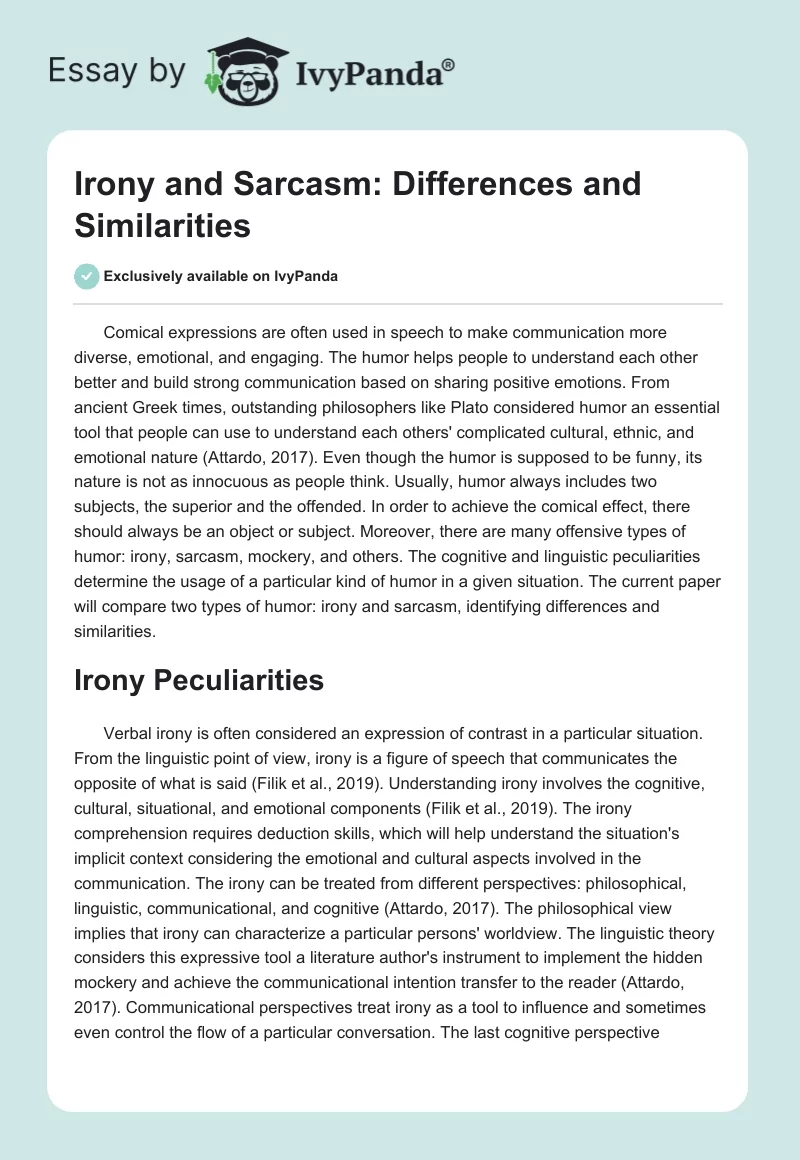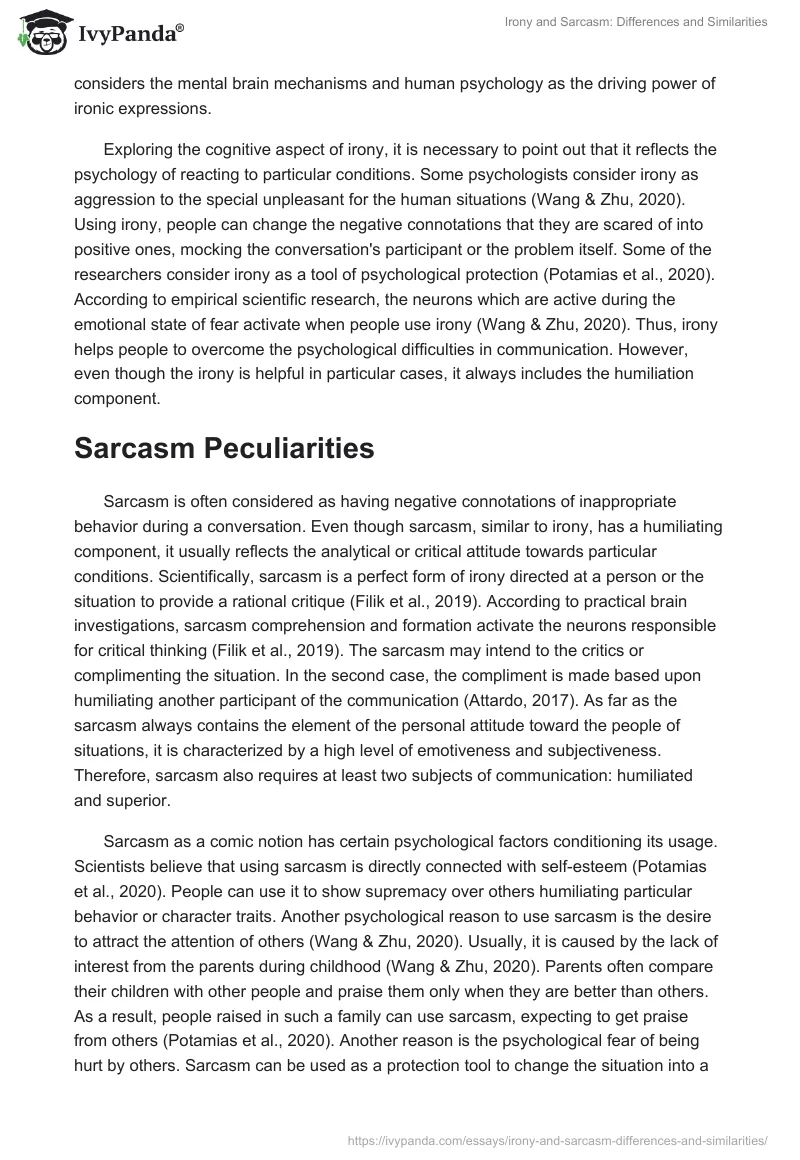Comical expressions are often used in speech to make communication more diverse, emotional, and engaging. The humor helps people to understand each other better and build strong communication based on sharing positive emotions. From ancient Greek times, outstanding philosophers like Plato considered humor an essential tool that people can use to understand each others’ complicated cultural, ethnic, and emotional nature (Attardo, 2017). Even though the humor is supposed to be funny, its nature is not as innocuous as people think. Usually, humor always includes two subjects, the superior and the offended. In order to achieve the comical effect, there should always be an object or subject. Moreover, there are many offensive types of humor: irony, sarcasm, mockery, and others. The cognitive and linguistic peculiarities determine the usage of a particular kind of humor in a given situation. The current paper will compare two types of humor: irony and sarcasm, identifying differences and similarities.
Irony Peculiarities
Verbal irony is often considered an expression of contrast in a particular situation. From the linguistic point of view, irony is a figure of speech that communicates the opposite of what is said (Filik et al., 2019). Understanding irony involves the cognitive, cultural, situational, and emotional components (Filik et al., 2019). The irony comprehension requires deduction skills, which will help understand the situation’s implicit context considering the emotional and cultural aspects involved in the communication. The irony can be treated from different perspectives: philosophical, linguistic, communicational, and cognitive (Attardo, 2017). The philosophical view implies that irony can characterize a particular persons’ worldview. The linguistic theory considers this expressive tool a literature author’s instrument to implement the hidden mockery and achieve the communicational intention transfer to the reader (Attardo, 2017). Communicational perspectives treat irony as a tool to influence and sometimes even control the flow of a particular conversation. The last cognitive perspective considers the mental brain mechanisms and human psychology as the driving power of ironic expressions.
Exploring the cognitive aspect of irony, it is necessary to point out that it reflects the psychology of reacting to particular conditions. Some psychologists consider irony as aggression to the special unpleasant for the human situations (Wang & Zhu, 2020). Using irony, people can change the negative connotations that they are scared of into positive ones, mocking the conversation’s participant or the problem itself. Some of the researchers consider irony as a tool of psychological protection (Potamias et al., 2020). According to empirical scientific research, the neurons which are active during the emotional state of fear activate when people use irony (Wang & Zhu, 2020). Thus, irony helps people to overcome the psychological difficulties in communication. However, even though the irony is helpful in particular cases, it always includes the humiliation component.
Sarcasm Peculiarities
Sarcasm is often considered as having negative connotations of inappropriate behavior during a conversation. Even though sarcasm, similar to irony, has a humiliating component, it usually reflects the analytical or critical attitude towards particular conditions. Scientifically, sarcasm is a perfect form of irony directed at a person or the situation to provide a rational critique (Filik et al., 2019). According to practical brain investigations, sarcasm comprehension and formation activate the neurons responsible for critical thinking (Filik et al., 2019). The sarcasm may intend to the critics or complimenting the situation. In the second case, the compliment is made based upon humiliating another participant of the communication (Attardo, 2017). As far as the sarcasm always contains the element of the personal attitude toward the people of situations, it is characterized by a high level of emotiveness and subjectiveness. Therefore, sarcasm also requires at least two subjects of communication: humiliated and superior.
Sarcasm as a comic notion has certain psychological factors conditioning its usage. Scientists believe that using sarcasm is directly connected with self-esteem (Potamias et al., 2020). People can use it to show supremacy over others humiliating particular behavior or character traits. Another psychological reason to use sarcasm is the desire to attract the attention of others (Wang & Zhu, 2020). Usually, it is caused by the lack of interest from the parents during childhood (Wang & Zhu, 2020). Parents often compare their children with other people and praise them only when they are better than others. As a result, people raised in such a family can use sarcasm, expecting to get praise from others (Potamias et al., 2020). Another reason is the psychological fear of being hurt by others. Sarcasm can be used as a protection tool to change the situation into a positive one. Using it, people diminish the person’s role in their mind, thereby eliminating the related pain (Wang & Zhu, 2020). As a result, the sarcasm has primarily negative connotations and reflects the psychological fear or desire to be noticed.
Comparative Analysis
After identifying principal linguistic and psychological peculiarities of irony and sarcasm, the subsequent step is to compare these phenomena identifying differences and similarities. According to the conducted literature exploration, it is essential to mention that sarcasm is considered the highest level of irony. Thus, they belong to the one satiric group and share particular common features (Attardo, 2017). Another common feature is that both comic expressions require profound deductive and communicational situation analysis skills for the speaker and listener. Moreover, when used in literature, irony and sarcasm perform similar functions: implementing the comic effect and conveying the author’s underlying message. From the cognition perspective, irony and sarcasm have the concept of communicational fear in common. The structure of both expressions is practically the same, including two components. Irony and sarcasm always address two events, people, or situations that are comically compared.
As was mentioned earlier, sarcasm is often considered a type of verbal irony. Even though the general verbal irony and sarcasm are comprising terms, there are significant differentiating features to discuss. Even though irony always has two components: superior and inferior, it is characterized by a lower level of humiliation than sarcasm (Potamias et al., 2020). The irony may be oriented toward reaching a comic effect without consciously identifying the person’s role, while sarcasm is consistently focused on providing harsh criticism. Another differentiating feature is that sarcasm is characterized by a higher level of emotiveness and subjectivism than irony (Wang & Zhu, 2020). As far as sarcasm incorporates the personal attitude towards the particular theme, it is more egocentric in character than irony.
From the linguistics perspective, sarcasm is more often used as an author’s instrument to provide a rational critique of a particular situation. The irony, in contrast, may be used to implement the comical effect only. However, it is sometimes used to reflect more general authors’ ideas without providing a large scale of implicit connotations (Attardo, 2017). Thus, these two types of humor are used for different purposes in literature writing.
Considering the cognitive nature of sarcasm and irony, they have both similar and differentiating features. The main similarity is that both of the humor expressions are used to hide the psychological fear and discomfort. Sarcasm is applied when people want to escape possibly harmful communication building, while irony can be helpful to direct the existing relationships into a psychologically convenient way (Wang & Zhu, 2020). The speakers can convert the negative aspects into positive ones by using verbal irony, thereby protecting themselves. Sarcasm, on the contrary, can only be helpful in rejecting protection, which is characterized by preventing relationship formation by humiliating people (Wang & Zhu, 2020). Unlike irony, sarcasm has additional psychological peculiarities correlated with self-esteem improvement and attention attraction. However, the concept of comparing people and situations lay in both comic expressions’ psychology (Wang & Zhu, 2020). Thus, according to the comparison, sarcasm is more often related to negative emotions, while irony can more often cause positive ones.
Therefore, according to the analyzed material and conducted comparative analysis, it is vital to highlight that irony and sarcasm are different phenomena. Even though they are often confused, each comic expression has unique features. Although sarcasm is a constituent of irony, it is more humiliating and thought-provoking in nature. The irony, in turn, is more neutral and does not necessarily focus on humiliation. These comic expressions have more differentiating than shared linguistic and psychological features. Generally, the similarities are in the humor belongings and psychological concept of fear. From the literature point of view, irony and sarcasm have different aims on a connotational level though generally, they both make the text more expressive. Therefore, irony and sarcasm have both similarities and differences, which are necessary to explore in order to understand the linguistic and psychological nature of these expressive means.
References
Attardo, S. (Ed.). (2017). The Routledge handbook of language and humor. Taylor & Francis Group.
Filik, R., Pitiotac, A., Ralph-Nearmana, K., & Turcan. A. (2019). What is the difference between irony and sarcasm?Cortex Journal, 1115, 112–122.
Potamias, R, Siolas, G. & Stafylopatis, A. (2020). A transformer-based approach to irony and sarcasm detection. Neural Computing and Applications, 32, 17309–17320.
Wang, Z., & Zhu, N. (2020). The paradox of sarcasm: Theory of mind and sarcasm use in adults. Personality and Individual Differences, 163, 2298–2306.


